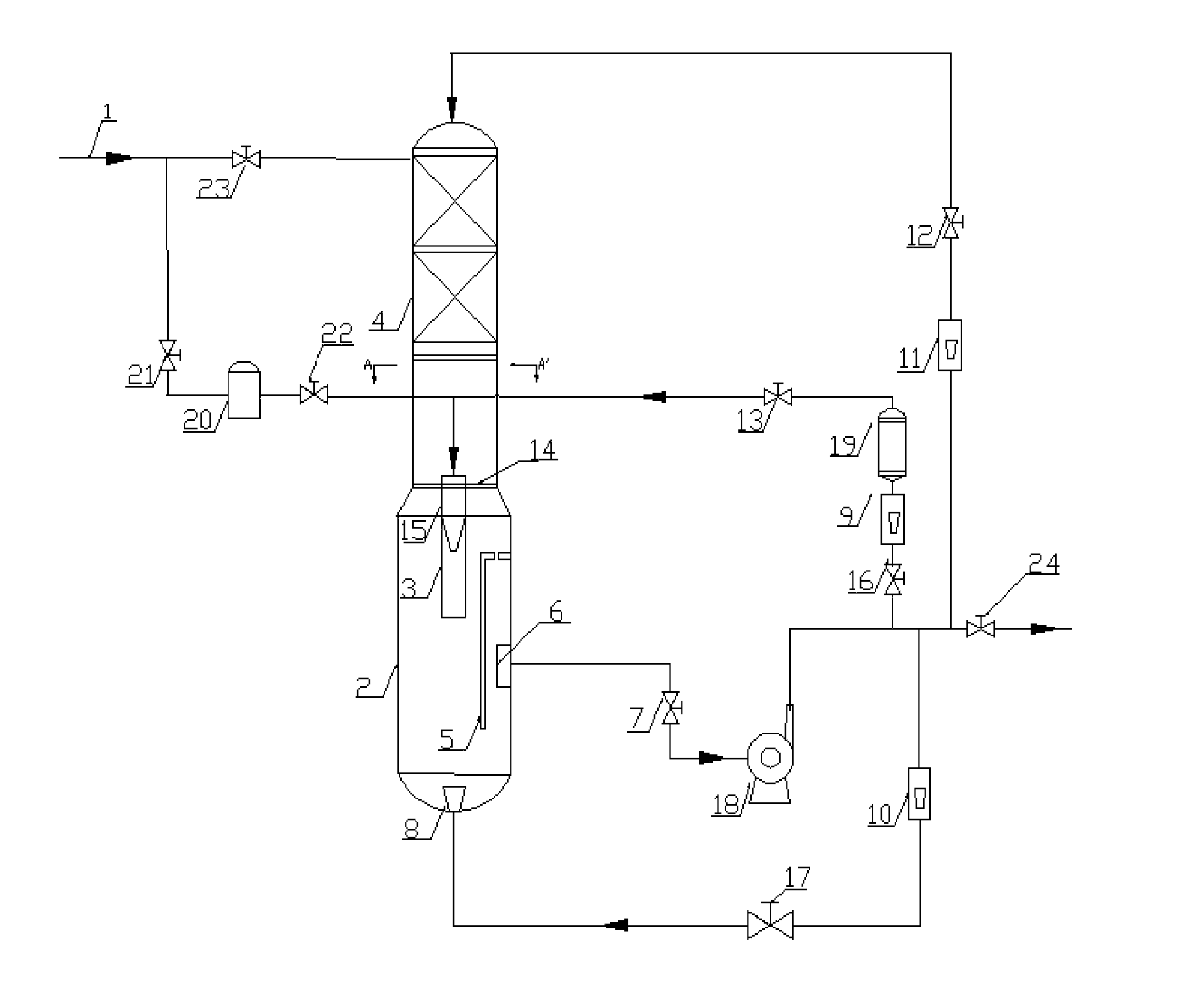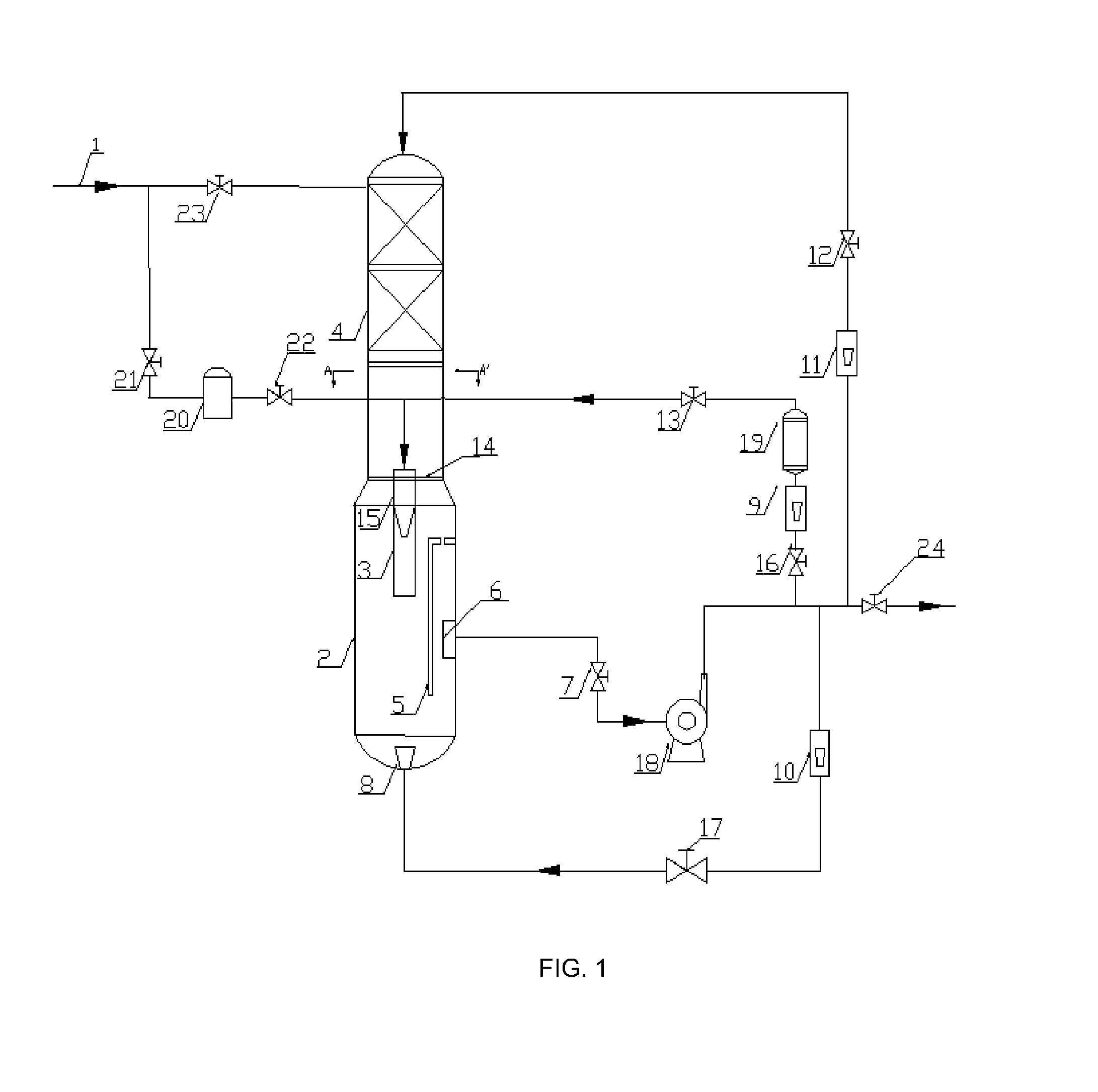Multiphase catalytic tower-type impinging-stream reactor
a reactor system and catalytic technology, applied in the direction of catalytic liquid-gas reaction, liquid-gas reaction process, chemistry apparatus and processes, etc., can solve the problems of poor thermal conductivity and difficult catalyst replacement, slow reaction rate, and difficulty in maintaining a continuous operating model
- Summary
- Abstract
- Description
- Claims
- Application Information
AI Technical Summary
Benefits of technology
Problems solved by technology
Method used
Image
Examples
embodiments
Embodiment 1 (Liquid-Liquid-Solid Three-Phase Reaction System)
[0029]Mixing dihydromyrcene, water and acetone at the mass ratio of 1:1:2, leading the mixture through the pipe 1 into the plate tower 4 for pre-reaction and then into the reaction kettle 2; the reaction kettle 2 has a volume of 6 m3, its diameter-height ratio being 1:1.5; the diameter of the packed tower 4 is a half of the diameter of the reaction kettle 2 while its height is similar to that of the reaction kettle 2; the packing used herein is 4 mm×4 mm θ rings made of 316L stainless steel. Turning on the valve 21 to lead a stream of the liquid material from the pipe 1 to the catalyst feeding device 20 so that it can mix with the solid catalyst (10% of the liquid material by mass ratio) and then flow into the reaction kettle 2. The solid catalyst adopted herein is Amberlyst 15 (manufactured by Rohm and Hass Company); keeping the reaction temperature at 100° C. and the reaction pressure at 0.5 MPa. The liquid in the react...
embodiment 2 (
Liquid-Liquid-Solid Three-Phase Reaction System)
[0030]The operating method is similar to Embodiment 1, wherein dihydromyrcene, water and ethanol are mixed at the mass ratio of 1:1:2; keeping the reaction temperature at 105° C. and the reaction pressure at 0.6 MPa; the solid catalyst used herein is Amberlyst 35 (manufactured by Rohm and Hass Company), and it is 20% of the liquid material by mass ratio. The obliquity of the holes at the periphery of the disc distributor on the lower ejector is 10°; the baffle plate of the static liquid zone is secured by means of screws; its two ends are 5 mm away from the top and bottom of the reaction kettle 2 respectively. The conversion rate of dihydromyrcene in the process adopted herein reaches 33.5%, and the reaction selectivity is higher than 70%.
embodiment 3 (
Liquid-Liquid-Solid Reaction System)
[0031]The operating method is similar to Embodiment 1, wherein acetic acid and n-butanol are mixed at the mole ratio of 2:1; keeping the reaction temperature at 85° C. and the reaction pressure at 0.15 MPa; the solid catalyst used herein is Amberlyst 15 (manufactured by Rohm and Hass Company) with modification, and the catalyst is 10% of the acetic acid by mass ratio; keeping 2 hours of reaction. The obliquity of the holes at the periphery of the disc distributor on the lower ejector is 15°; the baffle plate of the static liquid zone is secured by means of screws; its two ends are 5 mm away from the top and bottom of the reaction kettle 2 respectively. The conversion rate of n-butanol in the process adopted herein reaches 85% and the reaction selectivity 100%.
PUM
 Login to View More
Login to View More Abstract
Description
Claims
Application Information
 Login to View More
Login to View More - R&D
- Intellectual Property
- Life Sciences
- Materials
- Tech Scout
- Unparalleled Data Quality
- Higher Quality Content
- 60% Fewer Hallucinations
Browse by: Latest US Patents, China's latest patents, Technical Efficacy Thesaurus, Application Domain, Technology Topic, Popular Technical Reports.
© 2025 PatSnap. All rights reserved.Legal|Privacy policy|Modern Slavery Act Transparency Statement|Sitemap|About US| Contact US: help@patsnap.com



